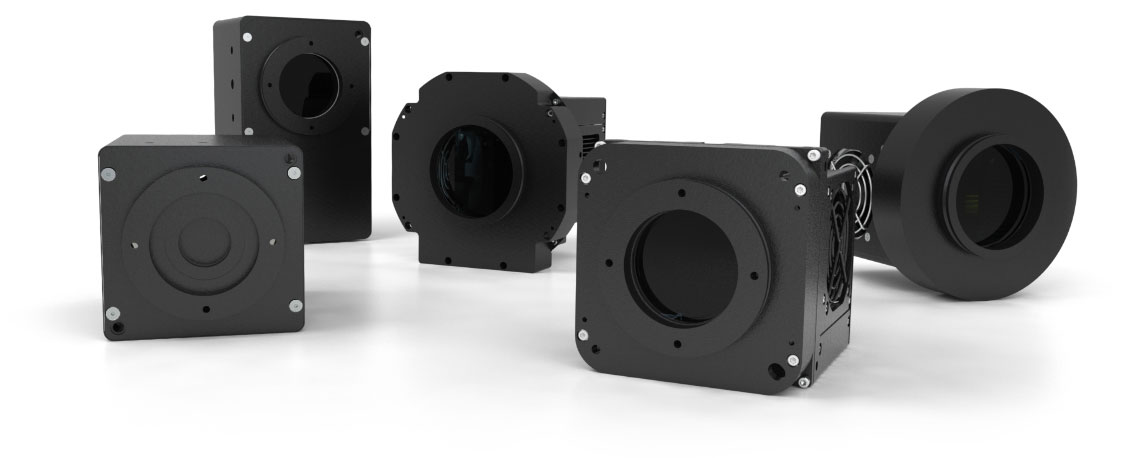
Life Science Optics


For over 20 years, life science OEMs have relied on us to provide thousands of cameras with exceptional value and consistent batch-to-batch performance. University and government research labs have looked to us for low volume solutions with optimized specifications. We have supported CCDs from ON Semi (formerly Kodak), Sony, Teledyne e2v, Hamamatsu, and Fairchild. In recent years, we’ve added scientific CMOS cameras, including board level imagers for integration into customers’ sub-systems. We will work with you to select the sensor technology that best fits your needs. IDEX Health & Science can then provide anything from an imaging system to a complete subsystem integrating optics, filters, illumination, and fluidics.
Kepler cameras add CMOS sensors and high speed to our product portfolio. The back-illuminated KL400 has a peak quantum efficiency of 95% and delivers 24 high dynamic range frames per second with 1.5 electrons noise. In 12-bit mode, an 80 x 2000 subarray can exceed 1000 frames / second. The larger area of the KL4040 (37 x 37 mm) is alternative to complex step-scanning solution. We will continue to add new CMOS sensors to address customers’ needs. Kepler KL cameras include USB 3.0 interfaces as well as a QSFP (quad small form factor pluggable) cages for high-speed fiber optic communication. Air cooling and plumbing for liquid circulation are standard. Electromechanical shutters are optional to ease acquisition of calibration dark images.
In 2021, KL2020 joined the Kepler family and provided a game-changing solution for life science applications. This OEM camera offers high QE, high frame rates, and exceptional SNR ratio at a very competitive price.
MicroLine and Hyperion cameras have long set the standards for price / performance for scientific CCD imaging. MicroLine cameras are small and lightweight, yet deliver extraordinary performance in cooling, noise, frame quality, and digitization bit-depth. With exceptionally low dark current and high sensitivity it makes it ideal for low light fluorescence applications.
Hyperion was developed for OEMS with a need for shorter distance front-to-back. MicroLines and Hyperions share electronics in differently shaped housings to satisfy customers’ mechanical requirements.
Sensors in all cameras are deep cooled in long-life maintenance-free sealed chambers. Regulated cooling stabilizes results for improved calibration. Cooling also minimizes thermally generated dark signal and maximizes dynamic range.
| KL400 | KL4040 | MLx285 | MLx695 | |
| Sensor Technology | CMOS | CMOS | CCD | CCD |
| Sensor Architecture | Back Illuminated / Front Illuminated | Back Illuminated / Front Illuminated | Front Illuminated | Front Illuminated |
| Peak QE (%) | 95 (BI) / 58 (FI) | 90 (BI) / 74 (FI) | 62 | 75 |
| Pixel Size (µm) | 11 | 9 | 6.45 | 4.54 |
| Array Size | 4 MP (2 K x 2 K) | 16 MP (4 K x 4 K) | 1.3 MP (1360 K x 1024 K) | 6 MP (2750 K x 2200 K) |
| Sensor Area (mm) | 22.5 x 22.5 | 36.9 x 36.9 | 8.8 x 6.6 | 12.5 x 10.10 |
| Diagonal (mm) | 31.9 | 52.1 | 11 | 16 |
| Full Well (e-) | 92 (BI) / 120 (FI) | 39 (BI) / 70 (FI) | 18 | 17 |
| Data Bit-Depth (bit) | 16 | 16 | 16 | 16 |
| Spectrum Capability (nm) | 200 - 1100 (BI) 300-1000 (FI) | 200 - 1100 (BI) 300-1000 (FI) | 300 – 1000 | 300 – 1000 |
| Dark Current (typical) | 0.4 eps @ -20 C (BI) / 0.2 eps @ -20 C (FI) | 1 eps @ -10 C (BI) / 0.15 eps @ -20 C (FI) | 0.001 eps @ -25 C | 0.0007 eps @ -30 C |
| Read Noise (e-; typical) | 1.6 (BI) / 1.5 (FI) | 2.1 (BI) / 3.7 (FI) | 4.5 | 3 |
| Shutter Type | Rolling | Rolling | Global | Global |
| Frame Rate | 24 / 48 | 23(QSFP) | 4 | 1.4 |
| Cooling | delta 45 C | delta 40 C | delta 60 C | delta 60 C |
| Interface | USB3 / QSFP | USB3 / QSFP | USB2 | USB2 |
| Binning | No | No | Yes | Yes |